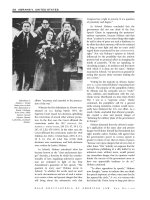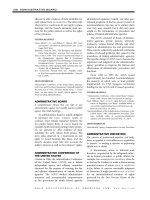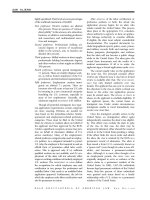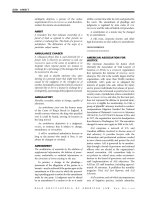Gale Encyclopedia Of American Law 3Rd Edition Volume 5 P55 doc
Bạn đang xem bản rút gọn của tài liệu. Xem và tải ngay bản đầy đủ của tài liệu tại đây (62.4 KB, 3 trang )
A DIVORCE premised on the ground of
irreconcilable differences is considered a no-
fault divorce since there is no need to establish
that one party is more responsible or at fault for
the end of the marriage than the other.
IRREGULARITY
A defect, failure, or mistake in a legal proceeding
or lawsuit; a departure from a prescribed rule or
regulation.
An irregularity is not an unlawful act, how-
ever, in certain i nstances, it is sufficiently
serious to render a lawsuit invalid. For example,
a number of states have statutes that require
the appointment of a guardian to represent
the interests of a child who is being sued. The
failure to do so is an irregularity that can be
used as a ground for invalidating and setting
aside a judgment entered against the child.
In other cases, however, the flaw might be a
simple
HARMLESS ERROR that can be easily
rectified, and, therefore, does not render the
proceeding invalid.
IRRELEVANT
Unrelated or inapplicable to the matter in issue.
Irrelevant evidence has no tendency to prove
or disprove any contested fact in a lawsuit.
IRREPARABLE INJURY
Any harm or loss that is not easily repaired,
restored, or compensated by monetary damages. A
serious wrong, generally of a repeated and con-
tinuing nature, that has an equitable remedy of
injunctive relief.
IRRESISTIBLE IMPULSE
A test applied in a criminal prosecution to deter-
mine whether a person accused of a crime was
compelled by a mental disease to commit it and
therefore cannot be held criminally responsible for
her or his actions; in a wrongful death case, a
compulsion to commit suicide created by the
defendant.
In most jurisdictions, a person may defend
criminal charges on a ground of insanity. The
INSANITY DEFENSE comes in two main forms.
First, a
DEFENDANT may argue that because of
mental disease or defect, he or she lacked the
capacity to distinguish right from wrong. This is
cognitive insanity.
Second, a defendant may argue that because
of mental disease or defect, she or he was unable
to act in conformance with the law. This is
volitional insanity, and it is known as the
irresistible impulse defense. Under this defense,
a defendant may be found not guilty by reason
of insanity even though she or he was capable of
distinguishing right from wrong at the time of
the offense.
The success of an irresistible impulse defense
depends on the facts of the case. For example,
assume that a child has been molested. If the
child’s mother shoots and kills the suspected
molester, the mother could argue that she was so
enraged by the violation of her child that she was
unable to control her actions. The mother need
not have been diagnosed as mentally ill. Rather,
she would need to show that she was mentally ill
at the time of the shooting, and that the illness
impaired her self-control.
Irresistible impulse emerged as a defense in
the nineteenth century, when psychoanalysts
formulated the concept of moral insanity to
describe the temporary inability of otherwise sane
persons to resist criminal behavior. Courts began
to recognize the condition as one that rendered
conduct involuntary and therefore not suitable
for punishment. For the better part of a century,
many states allowed both cognitive insanity and
irresistible impulse insanity as defenses.
Congress and most states abolished the
irresistible impulse defense after John Hinckley
was acquitted on grounds of insanity for the
attempted
ASSASSINATION of President RONALD
REAGAN
in 1981. Only a handful of states currently
allow irresistible impulse as a defense to criminal
charges. These states permit it as a supplement to
the cognitive insanity defense, which is the only
insanity defense recognized in most jurisdictions.
On the federal level, Congress abolished the
irresistible impulse defense in the Insanity
Defense Reform Act of 1984 (18 U.S.C.A. §§ 1
note, 17).
In some states, the irresistible impulse
defense has never been adopted. In others, it
has been adopted and subsequently withdrawn.
Where it has been rejected, the reasons are
generally the same: to prevent sane persons
from escaping liability simply because they were
unable to control their actions. In the words of
one court, “There are many appetites and
passions which by long indulgence acquire a
mastery over men but the law is far from
GALE ENCYCLOPEDIA OF AMERICAN LAW, 3RD E DITION
528 IRREGULARITY
excusing criminal acts committed under the
impulse of such passions” (State v. Brandon, 53
N.C. 463 [1862]).
Under the
MODEL PENAL CODE definition of
irresistible impulse, a person may be found not
guilty by reason of insanity if, at the time of the
offense, he or she lacked “substantial capacity
either to appreciate the criminality of [the]
conduct or to conform [the] conduct to the
requirements of law” (§ 4.01(1) [1962]). The
“lacked substantial capacity” language creates a
low threshold for the defendant: in so me states,
the defendant must allege complete impairment
in order to invoke the defense.
Irresistible impulse is also a factor in civil
actions. When a person commits suicid e, sur-
vivors may sue for damages with a
WRONGFUL
DEATH
claim or similar action if they can show
that the suicide was caused by the actions of
another person. In such a case, the plaintiffs
must prove that the defendant caused a mental
condition that caused the decedent to experi-
ence an irresistible impulse to commit suicide.
FURTHER READINGS
Falk, Patricia J. 1996. “Novel Theories of Criminal Defense
Based upon the Toxicity of the Social Environment:
Urban Psychosis, Television Intoxication, and Black
Rage.” North Carolina Law Review 74.
Gresham, Anne C. 1993. “The Insanity Plea: A Futile
Defense for Serial Killers.” Law & Psychology Review 17.
Kahan, Dan M. 1996. “Two Conceptions of Emotion in
Criminal Law. ” Columbia Law Review 96. Available
online at />3/Kahan.pdf; website home page: num-
bra.com (accessed August 2, 2009).
IRRETRIEVABLE BREAKDOWN
OF MARRIAGE
The situation that exists when either or both
spouses no longer are able or willing to live with
each other, thereby destroying their husband and
wife relationship with no hope of resumption of
spousal duties.
The irretrievable breakdown of a marriage
provides the ground for a no-fault
DIVORCE in
many jurisdictions.
IRREVOCABLE
Unable to cancel or recall; that which is unalterable
or irreversible.
IRS
See INTERNAL REVENUE SERVICE.
ISLAND
A land area surrounded by water and remaining
above sea level during high tide.
Land areas exposed only dur ing low tide are
called low-tide elevations or drying rocks, reefs,
or shoals. The existence of islands has generated
numerous disputes, centering primarily on the
size of the territorial sea surrounding an island
and the determination of what state has sover-
eignty over a particular island. The size of the
territorial sea has become an important question
affecting fishing rights and the right of unrestrict-
ed passage for foreign vessels. Although the
territorial sea of an island is usually determined
by reference to its coastal baseline, some adjust-
ments have been recognized in the cases of
archipelagoes and islands located close to the
mainland.
Determination of what state has title to an
island has traditionally depended upon an open
and continuous assertion of sove reignty over
the island, which is usually, but not always,
accompanied by physical presence of some
representative of the state .
CROSS REFERENCE
Territorial Waters.
ISSUE
To promulgate or send out. In a lawsuit, a
disputed point of law or
QUESTION OF FACT, set forth
in the pleadings, that is alleged by one party and
denied by the other.
In the law governing the transfer or distribution
of property, a child, children, and all individuals
who descend from a common ancestor or descend-
ents of any degree.
As applied to notes or bonds of a series, date
of issue means the day fixed as the start of the
period for which they run, with no reference to
a specific date when the bonds or notes are to be
sold and delivered. With regard to bonds only,
bonds are issued to the purchaser when they are
delivered.
When an issue of fact arises, the court or
jury mu st consider and evaluate the weight of
the ev idence in order to reach a decision. An
issue of law exists thereby providing a ground
for a
SUMMARY JUDGMENT sought by a party to the
action when only one conclusion can be drawn
by the court from the undisputed evidence,
obviating the need for deliberation by a jury.
GALE ENCYCLOPEDIA OF AMERICAN LAW, 3RD E DITION
ISSUE 529
The term issue is frequently found in
provisions of a deed. In TESTAMENTARY matters,
the meaning of issue i s derived from the intent
of the
TESTATOR, a maker of a will. The intent is
determined from the provisi ons of the will.
ISSUE PRECLUSION
A concept that refers to the fact that a particular
question of fact or law, one that has already been
fullylitigatedbythepartiesinanactionfor
which there has been a judgment on the merits,
cannot be relitigated in any future action
involving the same parties or their pr ivies
(persons who would be bound by the judgment
rendered for the party).
The term issue preclusion is synonymous
with
COLLATERAL ESTOPPEL, a doctrine which bars
the relitigation of the same issue that was the
basis of a finding or
VERDICT in an action by the
same parties or their privies in subsequent
lawsuits involving the same or different causes
of action. It is not, however, the same as the
doctrine of
RES JUDICATA which bars the relitiga-
tion of an entire
CAUSE OF ACTION,claimor
demand, as opposed to an issue that makes up a
cause of action, claim, or demand.
ITEMIZE
To individually state each item or article.
Frequently used in tax accounting, an item-
ized account or claim separately lists amounts
that add up to the final sum of the total account
on claim.
ITEMIZED DEDUCTION
See INCOME TAX.
GALE ENCYCLOPEDIA OF AMERICAN LAW, 3RD E DITION
530 ISSUE PRECLUSION









